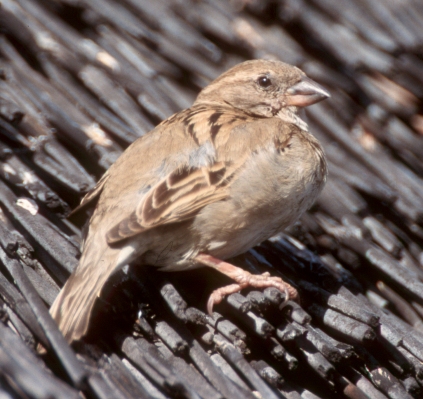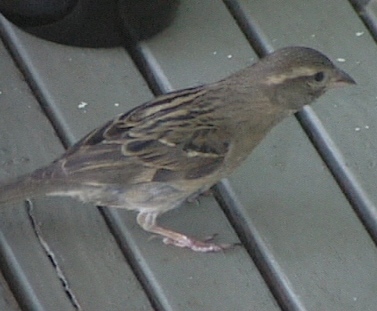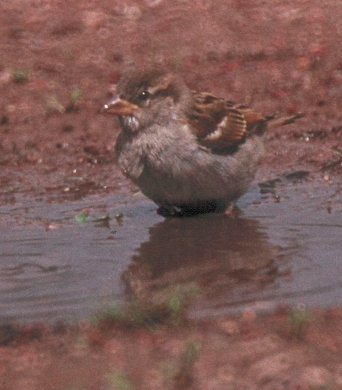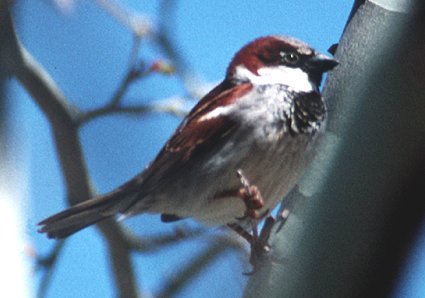|
House Sparrow Passer domesticus Gorrión Doméstico,
|
 |
|
Male - Photo: G. Beaton
|
|
House Sparrow Passer domesticus Gorrión Doméstico,
|
 |
|
Male - Photo: G. Beaton
|
|
The male has a black bib, gray crown, a white wing bar, and brown eye patch, back and wings. The female is a duller brown with light streaks on the back, and a buff eye line. Length: 15 cm.; weight: 27-30 g. The song is a simple series of cheery, chip notes. Audio 2 (M. Oberle). Introduced from Europe to many cities of the Americas, where the beginnings of geographic races have started to evolve just over the last century. This species is found in urban areas throughout Puerto Rico, Vieques and Culebra, especially on the south coast where it was noted to be common in Ponce in the 1970s. It is now common on Mona Island as well. The House Sparrow is thought to have been deliberately introduced or hitched a ride on cargo ships. It nests in holes in walls, light posts, or pipes, breeding throughout the year, but especially from March to September. Like many other birds, the House Sparrow frequently takes dust baths to clean its skin and feathers of parasites and excess oils. TAXONOMY: PASSERIFORMES; PASSERIDAE. Formerly called English Sparrow. |
 |
|
Female - Photo: G. Beaton
|
 |
|
Female - Photo: G. Beaton
|
 |
|
Female - Photo: G. Beaton
|
 |
|
Female - Photo: M. Oberle
|
 |
|
Female - Photo: M. Oberle
|
 |
|
Male - Photo: G. Beaton
|
 |
|
Male - Photo: M. Oberle
|
 |
|
Male - Photo: M. Oberle
|
|
References Camacho Rodríguez, M., J. Chabert Llompart, and M. López Flores. 1999. Guía para la identificación de las aves exóticas establecidas en Puerto Rico. Depto. de Recursos Naturales y Ambientales, San Juan, PR. García, M. A, C. E. Diez, and A. O. Álvarez. 2001. The impact of feral cats on Mona Island wildlife and recommendations for their control. Carib. J. Sci. 37:107-108. Jiménez, L. V. 1995. Datos prelininares de la expansión geográfica del Gorrión Inglés, Passer domesticus, en el oeste de Puerto Rico. El Pitirre 8(3):9. Johnston, R.F., and R.K. Selander. 1971. Evolution in the House Sparrow. II. Adaptive differentiation in North American populations. Evolution 25:1-28. Lowther, P. E. and C. L. Cink. 1992. House Sparrow (Passer domesticus). No. 12 in The birds of North America (F. Gill, A. Poole, and P. Stettenheim, eds.). Acad. Nat. Sci., Philadelphia, PA, and Am. Ornithol. Union, Washington, D.C. Martin, T. E., A. P. Moller, S. Merino, and J. Clobert. 2001. Does clutch size evolve in response to parasites and immunocompetence? Proc. Natl. Acad. Sci. U. S. A. 98:2071-2076. Miranda-Castro, L. 2000. La introducción de especies exóticas a Puerto Rico: un problema que nos afecta a todos. El Bien-te-veo 3(1):2-4. Moreno, Jorge A. 1997. Review of the subspecific status and origin of introduced finches in Puerto Rico. Carib. J. Sci. 33(3--4): 233--238. Pérez-Rivera, R.A. 1980. Algunas notas sobre el Gorrión Inglés Passer domesticus en Puerto Rico. Science-Ciencia 7(4):127-128. Raffaele, H.A. 1989. A guide to the birds of Puerto Rico and the Virgin Islands. Princeton. Raffaele, H.A. 1989. Una guía a las aves de Puerto Rico y las Islas Vírgenes. Publishing Resources, Inc., Santurce, PR. Raffaele, H.A. and C. B. Kepler. 1992. Earliest records of the recently introduced avifauna of Puerto Rico. Ornitología Caribeña 3:20-29. Raffaele, H.A., J.W. Wiley, O.H. Garrido, A.R. Keith, and J.I. Raffaele. 1998. Guide to the birds of the West Indies. Princeton. Next related species in taxonomic order Previous related species in taxonomic order |